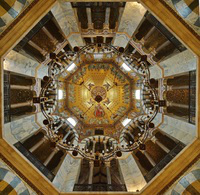Speaker
Description
Antimatter is believed to be affected by gravity in exactly the same way as ordinary matter for a variety of good reasons [1], however this has never been measured directly. This will be tested by the ALPHA-g project, which uses a new vertical antihydrogen trap based on the previous ALPHA design (Antihydrogen Laser Physics Apparatus, the first experiment to trap antihydrogen in 2010 [2]). As in previous ALPHA experiments, the trapped antihydrogen is detected via its charged annihilation products after switching off the trap. In order to be sensitive to small gravitational effects, the setup extends more than 2 metres in the vertical direction, requiring the particle detection system to cover a large volume with good tracking accuracy. The design chosen to replace the previous experiments' silicon strip detectors is a radial time-projection-chamber (rTPC) filled with an Argon/CO2 gas mixture.
Following successful tests with a smaller prototype, the full-scale chamber was completed in early 2018 and the basic functionality of the detector was established. Soon after, initial tests with cosmic rays lead to the observation of tracks due to charged particles. The concept and status of the detector system will we presented.
The specific parameters of the chamber together with the necessity to observe minimum-ionizing particles leads to relatively complex signals on the detector electrodes, which have to be deconvolved in an iterative process. The deconvolution algorithm and its results for both simulated and prototype signals are described.
[1] M. M. Nieto and J. T. Goldman, Phys. Rep. 205, 221-281 (1991).
[2] G. B. Andresen et al., Nature 7324, 673 (2010).
